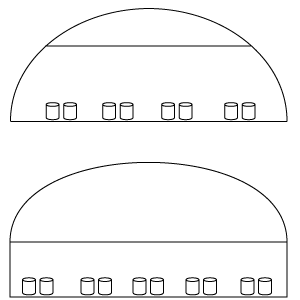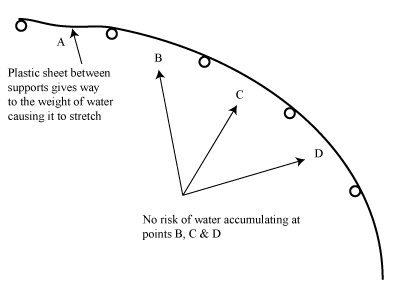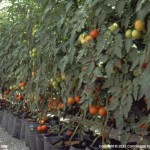Greenhouse size – Important factors to take into account
Greenhouse size is determined by the width and height. The height will determine climate inside the greenhouse and the width will determine what crops you will or can grow in the greenhouse. So what is the ideal greenhouse size; well, it is not a simple answer. It requires some holistic thinking, but let’s see what the scientist have said about the subject.
Various trials have concluded that height is one of the most important factors in reducing temperatures inside greenhouses found in tropical to arid climates, such as in Africa. The average height of greenhouses built in arid areas such as Africa is approximately 2.4m to the gutter and 1.6m to roof tip. The total height of the multi-span is 4m. It has been found however that the height in arid to tropical climates should be increased to at least 3m to the gutter for better ventilation and temperature control. A one meter reduction in gutter height, increases the minimum temperature by 0.37°C, increases the average temperature by 1.42°C and increases the maximum temperature by 3.56°C.1)Valencia, Nelson & Acuña, John & Valera, Diego. (2016).

Effect of the height of the greenhouse on the plant – Climate relationship as a development parameter in mint (Mentha Spicata) crops in Colombia. Ingeniería e Investigación. 36. 6-13.)) When using insect screenhouses the, ventiliation efficiency reached its peak at 4m.2)Teitel, M. & Liang, Hao & Tanny, Josef & Garcia-Teruel, Monica & Levi, Asher & Ibanez, Pablo & Alon, Hana. (2017). Effect of roof height on microclimate and plant characteristics in an insect-proof screenhouse with impermeable sidewalls. Biosystems Engineering. 162. 11-19.The greenhouse shape can influence the inside air temperature by 3.5-5.5°C during various hours of the day.3)Sethi, V.P.. (2009). On the selection of shape and orientation of a greenhouse for composite climates. International Journal of Sustainable Energy. 28. 45-58.

Increasing the greenhouse volume without increasing the ground surface area, improves thermal inertia, accelerates ‘buoyancy’ effect and improves natural ventilation4)Bouzo, Carlos. (2007). Effect of the greenhouse size on the internal temperature during warm period. Revista Cientifica Agropecuaria. 11. 111-119.
The average width of most multi-span greenhouses is less than 10m, usually 8-9m. The reason is that during rainy periods, puddles accumulate between the two top supports running longitudinally because of the plastic covering caving into the weight of the water. The problem only occurs on the top section and between the first two supporting bars on either side of the vent. Increasing the height of the roof or installing additional wire/cable between the first two longitudinal supports will reduce the risk of water accumulating on the plastic surface.
A comparison between the number of rows of tomatoes that can be planted in a conventional tunnel and that of a section of a multi-span (also called a bi-tunnel), one can clearly see that more plants can be fitted into a structure that has straight sides than those structures that have round sides.
References
| ↑1 | Valencia, Nelson & Acuña, John & Valera, Diego. (2016). |
|---|---|
| ↑2 | Teitel, M. & Liang, Hao & Tanny, Josef & Garcia-Teruel, Monica & Levi, Asher & Ibanez, Pablo & Alon, Hana. (2017). Effect of roof height on microclimate and plant characteristics in an insect-proof screenhouse with impermeable sidewalls. Biosystems Engineering. 162. 11-19. |
| ↑3 | Sethi, V.P.. (2009). On the selection of shape and orientation of a greenhouse for composite climates. International Journal of Sustainable Energy. 28. 45-58. |
| ↑4 | Bouzo, Carlos. (2007). Effect of the greenhouse size on the internal temperature during warm period. Revista Cientifica Agropecuaria. 11. 111-119. |



